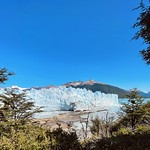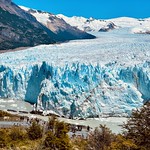Onto the glacier
This town’s name, El Calafate, comes from ‘caulk’, the material used to seal joints, but refers to a particular kind of berry that’s very common in the greater region. It’s even used to flavour beer from several breweries, including beer from at least four breweries in town.
The latter is testimony to how popular a tourist destination El Calafate is. Though with a bit of the feel of a border town, the central strip is very much developed, with fancy restaurants and cafes, and quite high prices.
The thing to see is the nearby glacier Perito Moreno. It’s inside a National Park, but you can just take a bus to get there.
Getting up early to catch this bus on Christmas Day, we walked to the bus station, and found all bakeries and supermarkets closed, but also plenty of teenagers coming back from their very late-night parties, still consuming their beverages. Argentines party late.
Back in Puerto Natales, Natalia and I had gotten each other presents that we were going to give each other on Christmas Eve. I had gotten her a wooly hat, she had gotten me a homemade pepper.
We used the pepper for the food we had on Christmas Eve.
When I opened the jar, the pepper released a little cloud of smoke, and it started to rise, until it was overflowing, like a little volcano, unto our table. We ate as much as we could, but couldn’t internalise everything.
Analysis made us suspect that an air bubble had been trapped in the jar which, at the higher altitude of El Calafate, had started to expend due to the lower air pressure.
The glacier is stunning, though you’re not allowed to get very close. Obviously immensely tempting, there are warnings against leaving the path everywhere. Apparently, before barriers were put up, dozens of people had died after being hit by pieces of the glacier falling down and then exploding on impact, either with the ground or the water.
The glacier is named after Francisco Pascasio ‘Perito’ Moreno, who was acquainted with Thomas Holdich, who walked the border between Argentina and Chile. The two men are linked via the work they did on the border commission, defining the separation between Argentina and Chile, but also via the rocky outcrop of ‘Piedra Holdich’, in Chubut province, where Moreno had inscribed, on a granite block, that he and Holdich had been there on the 29th April 1902.
As a ‘thank you’ for his part in the work on the border commission, Moreno, was given land in Patagonia and started to become known as ‘perito’ (meaning ‘expert’), for his work. Later, he donated land to his country, what is now the National Park of Nahuel Huapi, an area with a vast lake near Bariloche, where he eventually was buried.
Moreno himself had an English mother, and at some point managed to convince the Welsh community in Argentina to stay with the country, as opposed to allying themselves with Chile.
Yes, there’s a Welsh community in Argentina.
Moreno traveled a lot within the region, and is by some considered the last witness to the Indian world before it was decimated. In his writings, he combined travel writing with his scientific exploration, perhaps being a kind of Gonzo scientist.
At some point, Moreno was captured during a conflict between Indians and the Argentine state.
Sayhueque was the leader of all the Indian tribes in Patagonia, and he wanted to exchange Moreno for indigenous compatriots who had been captured. But many caciques, minor leaders, wanted Moreno dead. Sayhueque waited until after a particular feast would be over before making a decision, and Moreno knew that the whole tribe would get drunk on the apple-based alcohol which they brewed, a kind of chicha we later had in Osorno, in Chile.
Moreno planned to escape by a raft built from willow tree trunks, down the nearby river.
Moreno got his guards to drink a mixture of some herbs and seeds he had been carrying with him, which he knew would send them to sleep. Moreno and his two Indian partners escaped by horse the next night in the dark, leaving his theodolite under a blanket as if it was his body asleep, and pulling branches behind him to rub out the horses hoof marks.
After a week, running out of food, they saw camp smoke, fired the pistol he was still carrying, and unfurled an Argentinian flag he had kept under his military jacket.
They were picked up by a patrol shortly after.
Our journey was not as adventurous. After El Calafate, we took a bus to Bariloche, much further north, which took over 28 hours.







































